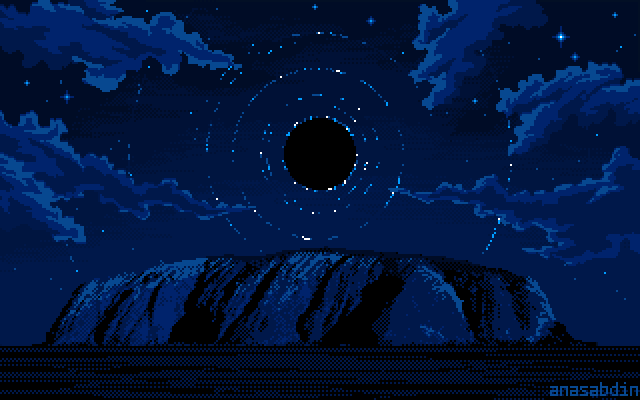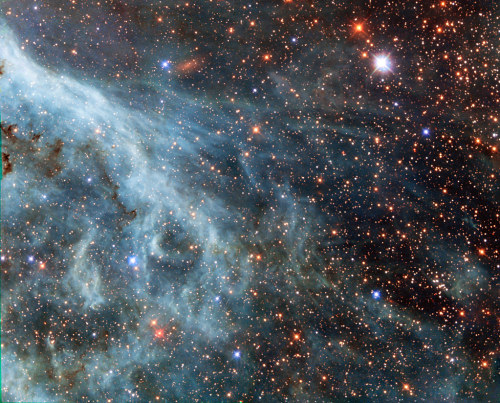Neptune’s Rings In Infrared © JWST


Neptune’s rings in infrared © JWST
More Posts from Of-finite-jurisdiction and Others
With NASA announcing their streaming service NASA+ and also announcing it’s going to be free and also ad free, I’d just like to appreciate the lengths they go to make scientific knowledge and exploration as available as they possibly can.

Uluru blackh●le rise, me, pixel art, 2022
IS THE UNIVERSE INFINITE??
Blog# 187
Wednesday, April 27th, 2022
Welcome back,
It’s one of the most compelling questions you could possibly ask, one that humanity has been asking since basically the beginning of time: What’s beyond the known limits? What’s past the edge of our maps? The ultimate version of this question is, What lies outside the boundary of the universe?
The answer is — well, it’s complicated.

To answer the question of what’s outside the universe, we first need to define exactly what we mean by “universe.” If you take it to mean literally all the things that could possibly exist in all of space and time, then there can’t be anything outside the universe. Even if you imagine the universe to have some finite size, and you imagine something outside that volume, then whatever is outside also has to be included in the universe.
Even if the universe is a formless, shapeless, nameless void of absolutely nothing, that’s still a thing and is counted on the list of “all the things” — and, hence, is, by definition, a part of the universe.

If the universe is infinite in size, you don’t really need to worry about this conundrum. The universe, being all there is, is infinitely big and has no edge, so there’s no outside to even talk about.
Oh, sure, there’s an outside to our observable patch of the universe. The cosmos is only so old, and light only travels so fast. So, in the history of the universe, we haven’t received light from every single galaxy. The current width of the observable universe is about 90 billion light-years. And presumably, beyond that boundary, there’s a bunch of other random stars and galaxies.
But past that? It’s hard to tell.

Cosmologists aren’t sure if the universe is infinitely big or just extremely large. To measure the universe, astronomers instead look at its curvature. The geometric curve on large scales of the universe tells us about its overall shape. If the universe is perfectly geometrically flat, then it can be infinite. If it’s curved, like Earth's surface, then it has finite volume.
Current observations and measurements of the curvature of the universe indicate that it is almost perfectly flat. You might think this means the universe is infinite. But it’s not that simple. Even in the case of a flat universe, the cosmos doesn’t have to be infinitely big. Take, for example, the surface of a cylinder.

It is geometrically flat, because parallel lines drawn on the surface remain parallel (that’s one of the definitions of “flatness”), and yet it has a finite size. The same could be true of the universe: It could be completely flat yet closed in on itself.
But even if the universe is finite, it doesn’t necessarily mean there is an edge or an outside. It could be that our three-dimensional universe is embedded in some larger, multidimensional construct. That’s perfectly fine and is indeed a part of some exotic models of physics. But currently, we have no way of testing that, and it doesn’t really affect the day-to-day operations of the cosmos.

And I know this is extremely headache-inducing, but even if the universe has a finite volume, it doesn't have to be embedded.
When you imagine the universe, you might think of a giant ball that’s filled with stars, galaxies and all sorts of interesting astrophysical objects. You may imagine how it looks from the outside, like an astronaut views Earth from a serene orbit above.
But the universe doesn’t need that outside perspective in order to exist. The universe simply is. It is entirely mathematically self-consistent to define a three-dimensional universe without requiring an outside to that universe. When you imagine the universe as a ball floating in the middle of nothing, you’re playing a mental trick on yourself that the mathematics does not require.

Granted, it sounds impossible for there to be a finite universe that has nothing outside it. And not even “nothing” in the sense of an empty void — completely and totally mathematically undefined. In fact, asking “What’s outside the universe?” is like asking “What sound does the color purple make?” It’s a nonsense question, because you’re trying to combine two unrelated concepts.
It could very well be that our universe does indeed have an “outside.” But again, this doesn’t have to be the case. There’s nothing in mathematics that describes the universe that demands an outside.
If all this sounds complicated and confusing, don’t worry. The entire point of developing sophisticated mathematics is to have tools that give us the ability to grapple with concepts beyond what we can imagine. And that’s one of the powers of modern cosmology: It allows us to study the unimaginable.
Originally published on https://www.space.com
COMING UP!!
(Saturday, April 30th, 2022)
“WHAT IS THE ELECTRON CLOUD THEORY??”










“Black Hole,” poem assembled from quotations from Wikipedia articles

Turquoise Plumes in the Large Magellanic Cloud by NASA’s Marshall Space Flight Center

NGC 1365, Heart of the Galaxy

NGC 6995: The Bat Nebula : Do you see the bat? It haunts this cosmic close-up of the eastern Veil Nebula. The Veil Nebula itself is a large supernova remnant, the expanding debris cloud from the death explosion of a massive star. While the Veil is roughly circular in shape and covers nearly 3 degrees on the sky toward the constellation of the Swan (Cygnus), NGC 6995, known informally as the Bat Nebula, spans only ½ degree, about the apparent size of the Moon. That translates to 12 light-years at the Veil’s estimated distance, a reassuring 1,400 light-years from planet Earth. In the composite of image data recorded through narrow band filters, emission from hydrogen atoms in the remnant is shown in red with strong emission from oxygen atoms shown in hues of blue. Of course, in the western part of the Veil lies another seasonal apparition: the Witch’s Broom Nebula. via NASA

Jupiter Rotates : Observe the graceful twirl of our Solar System’s largest planet. Many interesting features of Jupiter’s enigmatic atmosphere, including dark belts and light zones, can be followed in detail. A careful inspection will reveal that different cloud layers rotate at slightly different speeds. The famous Great Red Spot is not visible at first – but soon rotates into view. Other smaller storm systems occasionally appear. As large as Jupiter is, it rotates in only 10 hours. Our small Earth, by comparison, takes 24 hours to complete a spin cycle. The featured high-resolution time-lapse video was captured over five nights earlier this month by a mid-sized telescope on an apartment balcony in Paris, France. Since hydrogen and helium gas are colorless, and those elements compose most of Jupiter’s expansive atmosphere, what trace elements create the observed colors of Jupiter’s clouds remains a topic of research. via NASA

RS Puppis, one of the brightest Cepheid variable stars © Hubble
-
 mylittlegoldenbook reblogged this · 3 weeks ago
mylittlegoldenbook reblogged this · 3 weeks ago -
 catalllo reblogged this · 4 weeks ago
catalllo reblogged this · 4 weeks ago -
 midnightkissing reblogged this · 4 weeks ago
midnightkissing reblogged this · 4 weeks ago -
 staekiiiw reblogged this · 1 month ago
staekiiiw reblogged this · 1 month ago -
 adidasxgucci28 liked this · 1 month ago
adidasxgucci28 liked this · 1 month ago -
 unsane-emily reblogged this · 1 month ago
unsane-emily reblogged this · 1 month ago -
 zouislut reblogged this · 1 month ago
zouislut reblogged this · 1 month ago -
 robinniko reblogged this · 2 months ago
robinniko reblogged this · 2 months ago -
 frogewimbleton reblogged this · 2 months ago
frogewimbleton reblogged this · 2 months ago -
 robinniko liked this · 2 months ago
robinniko liked this · 2 months ago -
 stepsfrozenintime reblogged this · 3 months ago
stepsfrozenintime reblogged this · 3 months ago -
 anjels reblogged this · 3 months ago
anjels reblogged this · 3 months ago -
 anjels liked this · 3 months ago
anjels liked this · 3 months ago -
 whomstves reblogged this · 4 months ago
whomstves reblogged this · 4 months ago -
 m1sgu1d3dgh0stss reblogged this · 4 months ago
m1sgu1d3dgh0stss reblogged this · 4 months ago -
 inlovewithu-nicorns liked this · 4 months ago
inlovewithu-nicorns liked this · 4 months ago -
 urlocal-degenerate liked this · 4 months ago
urlocal-degenerate liked this · 4 months ago -
 by-9158 liked this · 4 months ago
by-9158 liked this · 4 months ago -
 lonelyingorgeousyeah liked this · 5 months ago
lonelyingorgeousyeah liked this · 5 months ago -
 zelzelem reblogged this · 5 months ago
zelzelem reblogged this · 5 months ago -
 zelzelem liked this · 5 months ago
zelzelem liked this · 5 months ago -
 luhannism liked this · 5 months ago
luhannism liked this · 5 months ago -
 dvrtbvg reblogged this · 5 months ago
dvrtbvg reblogged this · 5 months ago -
 itsmaddiebee liked this · 5 months ago
itsmaddiebee liked this · 5 months ago -
 upside-down-roses reblogged this · 5 months ago
upside-down-roses reblogged this · 5 months ago -
 hauntedbythenarrative reblogged this · 5 months ago
hauntedbythenarrative reblogged this · 5 months ago -
 ferventcore liked this · 5 months ago
ferventcore liked this · 5 months ago -
 last-haven liked this · 5 months ago
last-haven liked this · 5 months ago -
 haileyotakubeebe liked this · 5 months ago
haileyotakubeebe liked this · 5 months ago -
 elven-lcie reblogged this · 5 months ago
elven-lcie reblogged this · 5 months ago -
 elven-lcie liked this · 5 months ago
elven-lcie liked this · 5 months ago -
 lemonzephyrwings liked this · 5 months ago
lemonzephyrwings liked this · 5 months ago -
 artistpoet reblogged this · 5 months ago
artistpoet reblogged this · 5 months ago -
 sarazarahblog reblogged this · 6 months ago
sarazarahblog reblogged this · 6 months ago -
 lessproblematical reblogged this · 6 months ago
lessproblematical reblogged this · 6 months ago -
 kaletzz reblogged this · 6 months ago
kaletzz reblogged this · 6 months ago -
 arcanjus liked this · 6 months ago
arcanjus liked this · 6 months ago -
 poesia-silenciada liked this · 6 months ago
poesia-silenciada liked this · 6 months ago -
 live-as-never reblogged this · 6 months ago
live-as-never reblogged this · 6 months ago -
 externavel reblogged this · 6 months ago
externavel reblogged this · 6 months ago -
 externavel liked this · 6 months ago
externavel liked this · 6 months ago -
 novembersindigohues liked this · 6 months ago
novembersindigohues liked this · 6 months ago -
 tangledindream liked this · 6 months ago
tangledindream liked this · 6 months ago -
 jiljilec reblogged this · 6 months ago
jiljilec reblogged this · 6 months ago -
 jiljilec liked this · 6 months ago
jiljilec liked this · 6 months ago

Finn OFJ’s space blog. Do you love space?? you better. or else
39 posts

